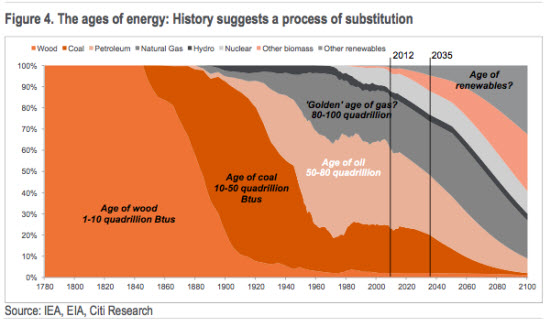 |
| Reviews and Templates for Expression We |
Citibank: Utilities are dinosaurs waiting to die

1
Quick Take: A new report authored by prominent Citibank analysts claims the global energy mix is shifting more rapidly than realized. If true – and these are some smart, smart people – it has major implications for generators, consumers, and most of all utilities. In fact, the study says utilities are most at risk because their business model is likely to change.
I've been arguing for years that utilities should either evolve to become "wires only" companies. Or else get busy offering additional services, such as rooftop solar and microgrids. For instance, in my "Electronomics" series, I explained why utilities MUST change their business model (and one way to get started).
This Citibank report suggests that the problem is even more urgent than we realized. Use the TalkBack form at the bottom to agree or disagree. - By Jesse Berst
Today's electric power utilities could lose half their addressable market to energy efficiency, solar and storage, and other distributed generation, according to “Energy Darwinism – the evolution of the energy industry," a new report from the investment banking arm of Citibank.
“Consumers face economically viable choices and alternatives in the coming years which were not foreseen 5 years ago,” the analysts write. According to REneweconomy, the price fall of solar panels has exceeded all expectations, resulting in cost parity being achieved in certain areas much more quickly. “The key point about the future is that these fast ‘learning rates’ are likely to continue, meaning that the technology just keeps getting cheaper. At the same time, the alternatives of conventional fossil fuels are likely to gradually become more expensive.”
“This is not a ‘tomorrow’ story. We are already seeing utilities altering investment plans, even in the shale-driven U.S., with examples of utilities switching plans for peak-shaving gas plants, and installing solar farms in their stead,” the report says.
Even wind may cut into traditional approaches, despite its intermittency. Citi says that while wind’s intermittency is an issue, with more widespread national adoption it begins to exhibit more baseload characteristics (i.e. it runs more continuously on an aggregated basis). “Hence it becomes a viable option, without the risk of low utilisation rates in developed markets, commodity price risk or associated cost of carbon risks.”
Citi admits that storage is still a nascent industry, but so was solar 5 to 6 years ago. “The increasing levels of investment and the emergence of subsidy schemes which drive volumes could lead to similarly dramatic reductions in cost as those seen in solar, which would then drive the virtuous circle of improving economics and volume adoption.”

How fast will the changeover take place? Citi says history tells us that such changes are never gradual, citing the graph below as evidence.
|
|
|
|
Copyright 2011 Energy and Technical Services Ltd. All Rights Reserved. Energyts.com |